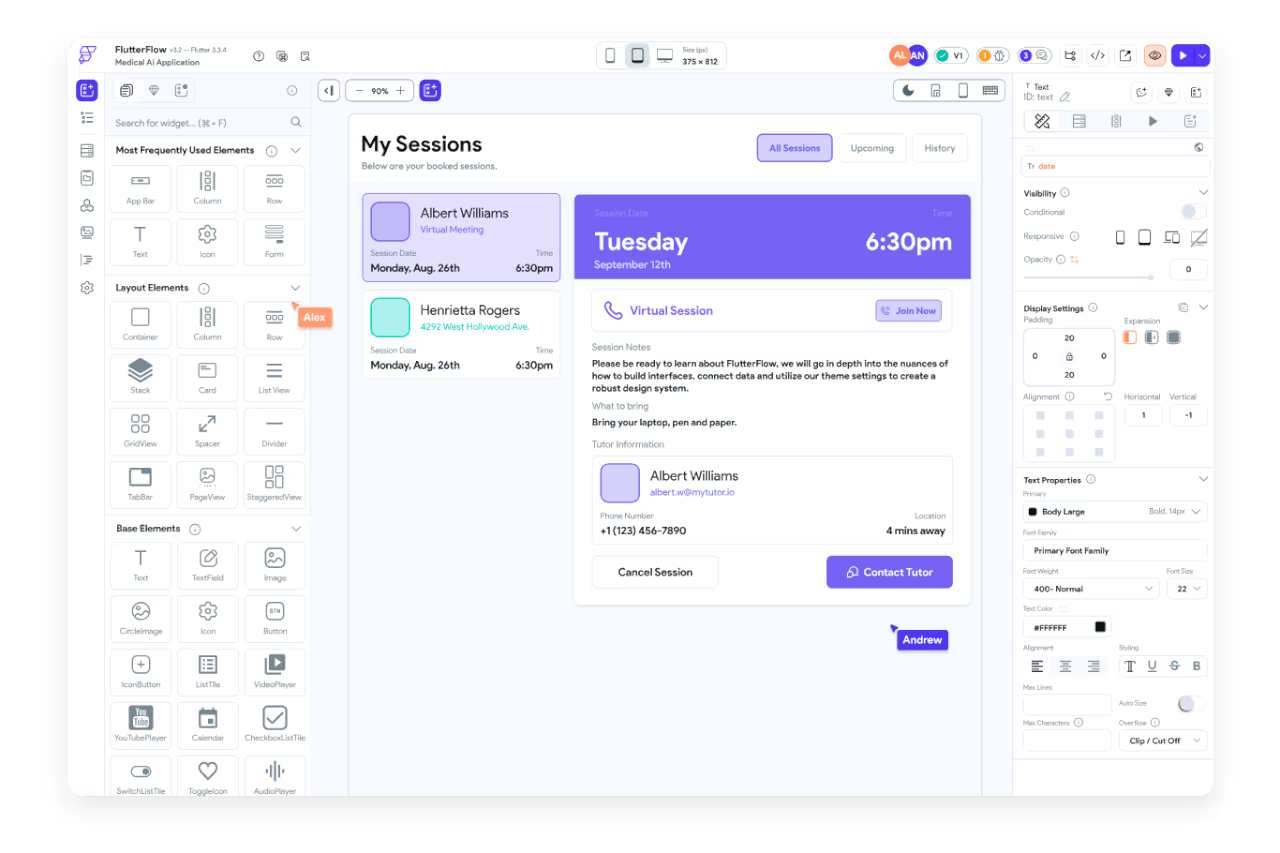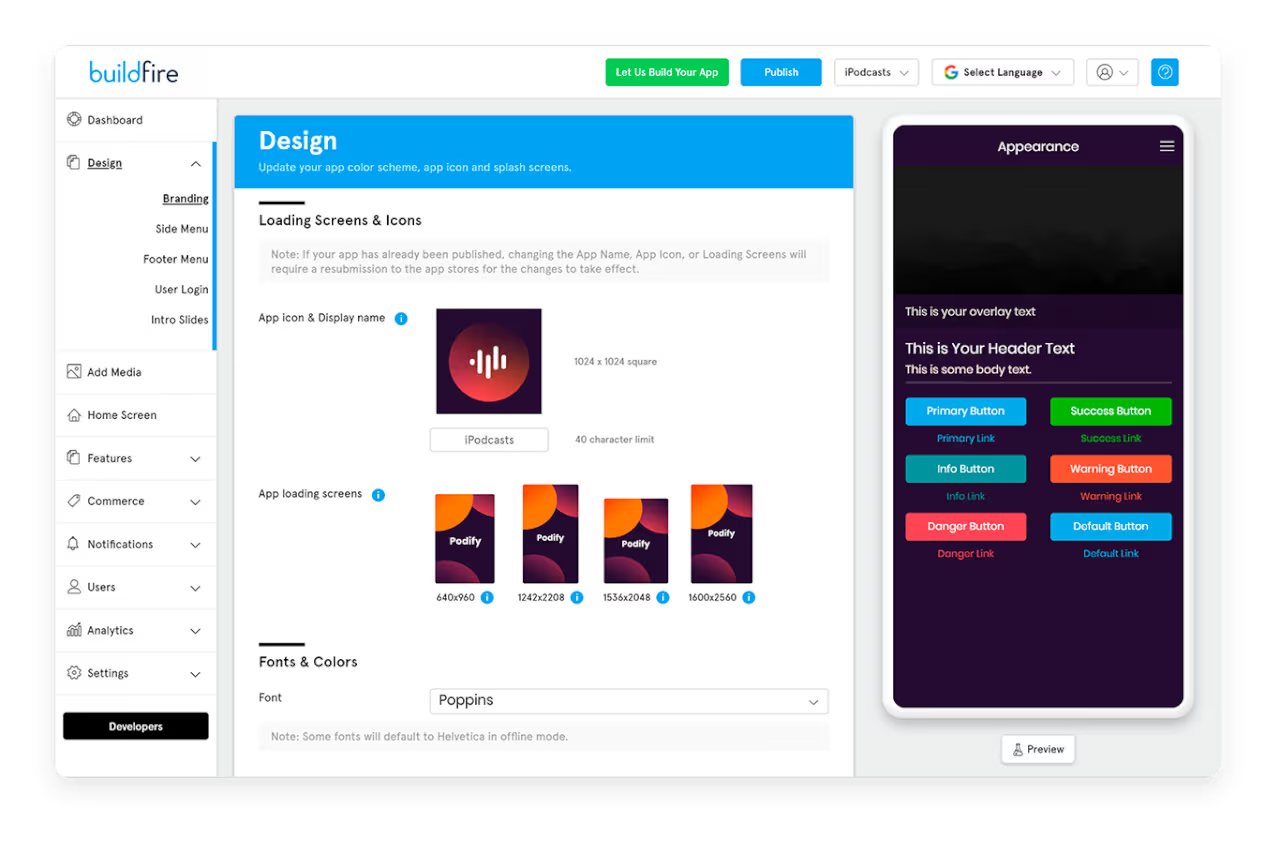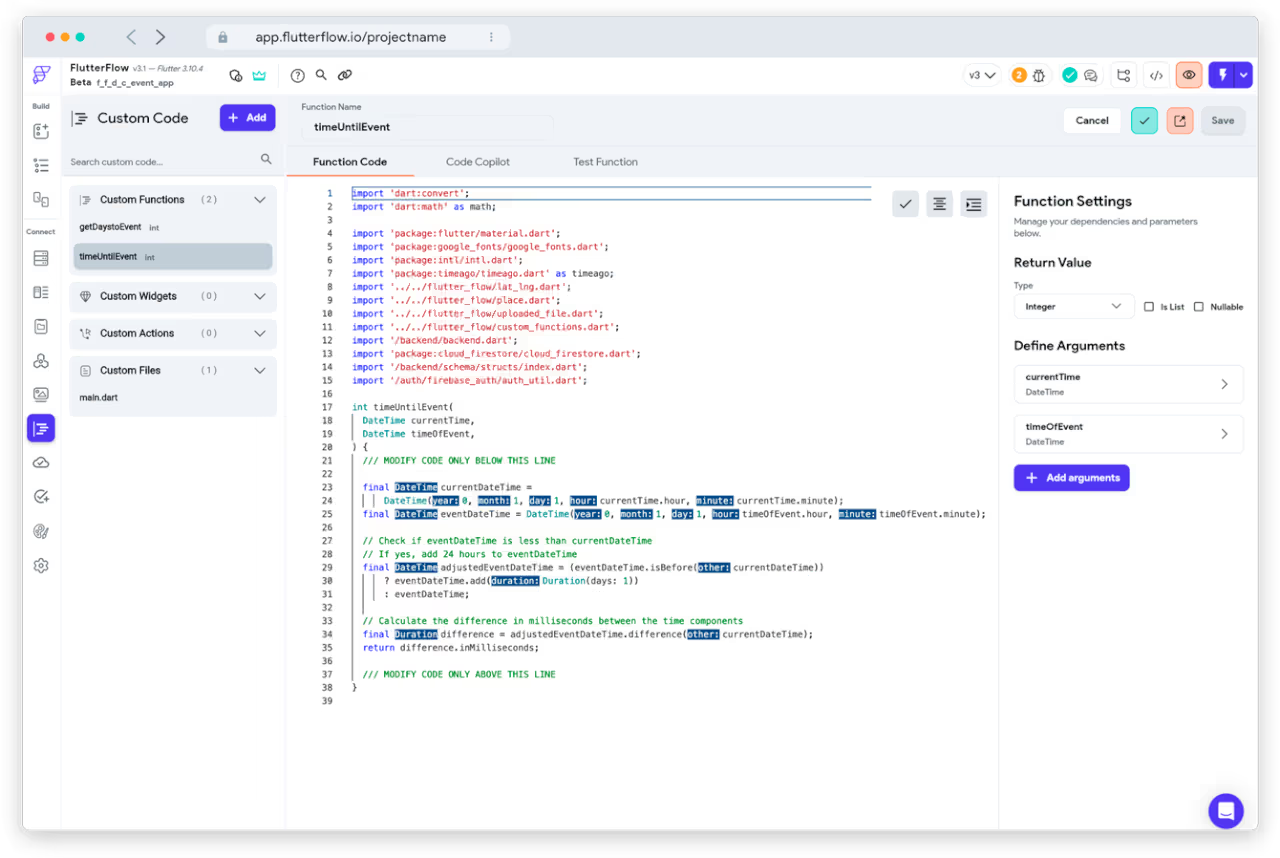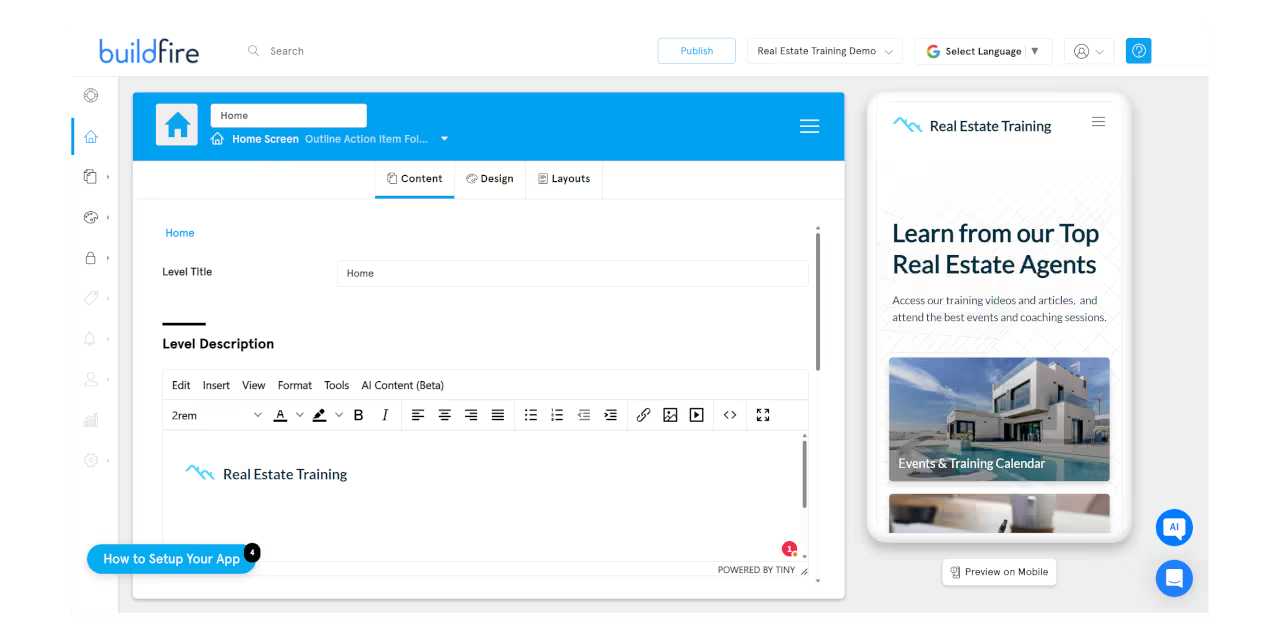FlutterFlow vs BuildFire: Why FlutterFlow takes the lead
20 min
read
Discover why FlutterFlow outshines BuildFire for custom app development. Dive into the strengths, flexibility, and best use cases of each platform.

Introduction
There's no doubt technology is redefining the business landscape. To stay competitive, businesses must rapidly adapt to market changes, innovate, and meet the growing demand for software solutions. In this changing scenario, low-code and no-code platforms have been gaining ground rapidly and becoming essential for businesses of all sizes. Thus, embracing the appropriate platforms can be the key to success in this evolving digital landscape.
Low-code and no-code development has been revolutionizing the way software applications are developed and deployed, making them more efficient, reducing costs as well as improving accessibility. In today’s landscape, many businesses and organizations are choosing to work with low-code and no-code tools and platforms. However, selecting the ideal platform for your unique requirements can be a challenging endeavor.
In this article, we'll explore two of the most robust platforms that will allow you to build native apps: BuildFire and FlutterFlow. We’ll go through their features, performance and scalability, their costs and how they are shaping the future of software development. Let's dive in!
Key features comparison
What is FlutterFlow?
FlutterFlow is a visual app development platform that allows users to create mobile applications using a drag-and-drop interface, while also offering the ability to add custom code for advanced functionality. It offers property customization, which allows users to customize the appearance and widget’s reaction through a comprehensive set of visual settings. Regarding design, FlutterFlow’s platform also offers a responsive design, since it offers a wide selection of build layouts that adapt automatically to different screen sizes and devices.
It is built on top of Google's Flutter framework, which is known for its fast performance and cross-platform capabilities. You can also export the code and migrate your whole app to Flutter.
Related: What is FlutterFlow? Everything you need to know about FlutterFlow development

What is BuildFire?
BuildFire is a versatile app development platform that enables users to create, customize, and manage mobile apps without any code skills. It comes with pre-made components, making it more user-friendly. It also offers analytics, push notifications, and an app store where you can submit your app. The platform supports both iOS and Android app development, allowing creators to reach a wide audience with a single build process.
In addition to its no-code approach, BuildFire provides a range of powerful features to enhance app functionality and user engagement. The platform offers integrations with popular third-party services, allowing developers to incorporate features like social media sharing, e-commerce capabilities, and content management systems. BuildFire also includes a wide set of customization options, enabling users to customize the appearance and feel of their apps to match their brand identity. For those who require more advanced functionality, BuildFire provides a JavaScript SDK, allowing developers to extend the platform's capabilities and create unique, custom features for their apps.

Key Insights for App Development
UI/UX Design: Customization or Simplicity?
FlutterFlow
FlutterFlow's customizable and intuitive interface helps simplify the process of app creation. But that's not all! In addition, to improve the user experience, you can easily implement engaging animations without diving deep into code. Another key feature is its visual editor where you can have a real-time preview of your app while developing it. Its design flexibility, customization, and creativity, make it a great choice for complex, visually appealing applications.
Buildfire
Instead, Buildfire positions itself as a great fit for individuals and businesses prioritizing simplicity and functionality in app development. Its intuitive interface features a wide array of pre-built templates and plugins, making it exceptionally accessible to non-designers users and also for those with limited technical expertise. While the platform's design capabilities may be more constrained compared to some alternatives, this limitation is often outweighed by its ease of use. Buildfire excels in providing a streamlined approach to app creation, allowing users to rapidly prototype and launch their ideas. In essence, this platform is ideally suited for entrepreneurs, small businesses, and organizations seeking a more straightforward and efficient development process, without the need for extensive coding knowledge or design skills.
Development Tools and Workflow
Drag and Drop Interface
Both FlutterFlow and BuildFire offer intuitive and robust drag-and-drop interfaces, encouraging developers and users with a non-technical background to take control of their application development process. This visual approach to app creation significantly reduces the learning curve and accelerates the development timeline. However, the main differentiator between these tools lies in their approach to customization:
FlutterFlow
FlutterFlow leverages the power of Flutter's framework to provide extensive customization options. Users can rapidly prototype and design their apps using no-code and low-code tools, creating a functional foundation with ease. For those requiring highly specialized functionality or unique features, FlutterFlow offers the flexibility to integrate custom code seamlessly. This hybrid approach caters to a wide range of developers, from beginners to experienced programmers, allowing for scalable and highly tailored applications.
BuildFire
In contrast, BuildFire prioritizes speed and simplicity through its library of pre-made templates and modules. This approach significantly accelerates the development process, allowing users to create functional apps in a fraction of the time compared to traditional code methods. The user-friendly interface simplifies the app-building journey, making it accessible to those with limited technical expertise. However, this ease of use comes with certain limitations in terms of customization. BuildFire does not support custom code, which may restrict the ability to implement highly specific or unique features beyond the platform's existing capabilities.
The choice between these platforms often depends on the project's requirements, the desired level of customization, and the development team's technical expertise. FlutterFlow offers greater flexibility and control for those willing to delve into custom code, while BuildFire provides a faster route to market for more standardized applications.
Code Integration
When analyzing Code integration, FlutterFlow stands out for its flexibility. It allows integration of custom code written in Dart - the programming language used by Flutter, Google's mobile app toolkit, making it easier for users to integrate custom code to implement advanced features.
Additionally, FlutterFlow allows you to import and integrate open-source resources like maps, data charts, animations, etc. But that's not all, with FlutterFlow you can export your app's code as Flutter code, and continue working on it using traditional Flutter's development tools like Android Studio.
When it comes to BuildFire, even though it's a versatile no-code solution, it has limited support for integrating custom code. This easy-to-use platform's templates and plugins can be tweaked and tailored to the user's needs, but just relying on its built-in features can be a problem for those needing specialized functionalities.

Collaboration
Teamwork is vital for app development as it brings together individuals from different backgrounds and with diverse skills to create innovative and user-friendly applications. Both BuildFire and FlutterFlow provide features that enable multiple users to access and work on projects or apps simultaneously. Let's examine the differences they offer in terms of collaboration:
FlutterFlow
FlutterFlow integrates with version control systems, helping large teams manage changes more effectively and efficiently. This low-code platform enables developers to track modifications, revert to previous versions, and manage iterations, which are crucial features for teams working on complex projects.
FlutterFlow also offers a real-time collaboration feature, in which multiple team members can work on the same project simultaneously, seeing each other's changes in real-time. It offers role-based access control, which is the ability for administrators to assign different roles and permissions to team members, ensuring that each person has appropriate access to project resources. And lastly, it offers a comment and feedback system, where team members can leave comments on specific elements of the design or code, facilitating communication and quick issue resolution.
BuildFire
While BuildFire doesn't provide built-in collaboration features as comprehensive as FlutterFlow's, it does offer several features that can facilitate workflow:
The first one is the shared access feature, which allows multiple team members to access the same project, although not simultaneously. It allows for real-time updates, that is, changes made by one team member and immediately visible to others upon refresh. It offers a plugin marketplace, where teams can collaborate by sharing and integrating plugins developed by different team members. And, lastly, a preview and testing feature, which allows team members to easily share app previews for feedback and testing purposes.
In summary, while both platforms offer collaborative features, FlutterFlow provides more advanced tools for growing, scalable and personalized projects, whereas BuildFire's collaboration features are more suited to simpler projects, in which users know how to integrate third party plugins and value simplicity. The choice between the two would depend on the complexity of your project, and your specific collaboration needs.
Speed of development & Iteration
Speed of development and iteration are essential in any app creation process, allowing teams to respond quickly to market changes, gather user feedback, and continuously improve their products. Rapid iteration cycles can significantly reduce time-to-market and help businesses stay competitive in the fast-paced mobile app landscape.
FlutterFlow
FlutterFlow's visual interface, combined with Flutter's powerful framework, makes it a formidable tool for prototyping, testing, and iteration. Users can adjust their app's layout and features rapidly while incorporating more complex elements through custom code. This flexibility is vital to achieve better results, helping teams work more efficiently.
As we have already reviewed in this article, there are some features that help with the speed of development, as for example the drag-and-drop interface the platform provides, which allows for quick UI changes without code. Also the real-time preview, which allows users to Instantly see how changes affect the app across different devices. For more experienced creators and developers, FlutterFlow offers a code export feature, which offers the ability to export Flutter code for further customization. And, lastly, the collaborative features, which allows team members to work simultaneously on different app aspects.
BuildFire:
BuildFire's platform provides pre-built plugins and modules that can be easily integrated into an app. Iteration, in this case, involves selecting and configuring these features rather than developing custom code, which speeds up the process. This platform's compatibility with third-party tools also enables users to iterate by connecting with external sources. As we have seen, BuildFire offers a plugin marketplace, where users can acquire ready-to-use features. Its no-code configuration allows users to easily adjust settings and appearance without programming.
Both platforms offer unique advantages in terms of development speed and iteration capabilities. FlutterFlow provides more flexibility for custom development while maintaining rapid prototyping abilities. BuildFire, on the other hand, excels in quick deployment of standard features and ease of updates.

Deployment
When it comes to the deployment of products created on each platform, there are significant differences worth examining:
FlutterFlow
FlutterFlow enables users to build applications for Android, iOS, and the web using a single codebase, streamlining management and updates across different platforms. This cross-platform capability significantly simplifies the deployment process, reducing time and effort. It's a key advantage for developers aiming to create apps that function seamlessly across various devices.
One of FlutterFlow's strengths is its seamless integration with Firebase and other backend services, facilitating the development of apps with advanced features such as real-time updates, user authentication, and cloud functions. This integration enhances the app's functionality and scalability.
BuildFire
BuildFire focuses primarily on mobile app development for iOS and Android. This low-code platform automates the app deployment process, enabling users to publish their apps to the App Store and Google Play without grappling with the complexities of managing separate codebases for different platforms. This feature is particularly beneficial for non-developer users, significantly lowering the barrier to entry for app creation and distribution.
BuildFire also provides a range of publishing services, including app store optimization (ASO) assistance, which can help improve an app's visibility and discoverability on app stores. Additionally, the platform offers over-the-air (OTA) updates, allowing developers to push changes to their apps without going through the app store review process each time.
Both platforms offer cloud-based deployment options, ensuring that apps can be easily scaled and maintained without significant infrastructure investment from the developer. However, FlutterFlow's web deployment capabilities give it an edge for businesses looking to maintain a consistent user experience across mobile and web platforms.
Data management and backend: why are they crucial?
Data integration is much more than just data synchronization. Every second massive amounts of data are being generated and collected. But even though this data may be incredibly valuable, it can also become a challenge to manage effectively. When you build your app, you'll most likely need to connect with external services or data sources, so that's where integration plays a crucial role.
FlutterFlow
In FlutterFlow's case, as it's natively integrated with Firebase, it is easy to set up and manage databases, authentication, and real-time data. And that's not all, it also has a robust API integration, allowing it to interact with multiple systems or pull in data from various sources. This may be done through pre-built integrations such as Slack or Google Analytics, and also build custom integrations through FlutterFlow's API calls.
BuildFire
BuildFire instead comes with its own backend system that is integrated with the platform's pre-built features. This backend is designed for ease of use, offering a simplified data management experience without requiring deep tech knowledge. A closed environment like this one may be helpful and make setup easier but limits flexibility for complex data-driven applications. BuildFire also provides API integration options but through pre-configured modules. This is ideal for users who need to integrate simple APIs or pull in data from standard sources without dealing with the complexities of custom API setups.
Scalability and performance: Essentials for handling growth and user experience
Scalability and performance are critical factors in app design, serving as the foundation for long-term success and user satisfaction. They ensure the system can gracefully handle increasing user demands, maintain a responsive and fluid user experience, and adapt to evolving requirements as the application grows.
FlutterFlow
FlutterFlow leverages the power of Flutter, which is known for its excellent performance across platforms. The framework's architecture allows for efficient rendering and smooth animations, contributing to a responsive user interface even as the app scales. FlutterFlow's built-in state management solutions and code generation techniques help maintain performance as the app's complexity increases. However, developers should be mindful of potential bottlenecks when integrating complex custom code or handling large datasets.
BuildFire
BuildFire's platform is designed utilizing a modular approach, based on building blocks of functionality to build your app, which allows easy feature expansion without compromising performance. The platform's cloud-based infrastructure provides the flexibility to scale resources as user demand grows. BuildFire's optimization techniques, such as efficient API calls and caching mechanisms, help maintain responsiveness even with increased user loads. However, heavily customized apps or those relying extensively on third-party plugins may require additional performance tuning to ensure optimal scalability.
Both platforms offer tools and best practices to monitor and optimize app performance, such as analytics integrations and performance profiling features. Developers should regularly assess their app's performance metrics and user feedback to identify and address any scalability challenges proactively.
App Performance
As FlutterFlow is built on Google's Flutter framework, you can create high-performance native apps. Flutter's performance benchmarks are well-documented, with apps running without problem on modern devices and offering a responsive and fluid user experience. The platform also allows developers to use Flutter's native performance optimization tools, such as the Flutter DevTools, to monitor and improve app performance. This ensures that the app remains fast and efficient even as it becomes more complex.
BuildFire's platform uses pre-built modules to ensure that most apps perform well. Its design focuses on delivering a solid user experience performing reliably within its intended scope. However, the lack of deep customization options may limit the ability to optimize performance for very specific or high-demand scenarios.
Data volumes and complexity
FlutterFlow
FlutterFlow’s integration with Firebase's robust backend is designed to handle large-scale applications with a large number of users, which makes it an interesting solution when managing important data volumes without sacrificing performance. FlutterFlow also allows users to connect their platform with other very powerful and scalable data sources, such as Supabase.
BuildFire
When analyzing BuildFire's backend we must stand out that it has been designed to make things simple for non-tech users. Its modular approach works well for apps with moderate data needs. However, for larger applications that require extensive data processing or real-time updates, BuildFire may face limitations due to its more constrained infrastructure.
App scalability
FlutterFlow
When it comes to scalability, FlutterFlow generates clean and readable code that follows Flutter and Dart's best practices and conventions making data easy to understand, and scale. FlutterFlow's reliance on Firebase ensures handling large amounts of data and users, making it suitable for apps expected to scale significantly over time. This means you can start small and then add more features in the future. For apps that require more than what Firebase offers, FlutterFlow integrates with custom backends such as AWS, Azure, or other cloud services.
BuildFire
In BuildFire's case and with simplicity being its hallmark, performance is optimized through its pre-built modules and controlled environment, ensuring that apps run smoothly. This platform is designed to handle a moderate scale of users and data efficiently, which is great for small to medium-sized applications.
We understand that this information can be a lot to take in. You don't have to navigate it on your own—our expert team is here to help. Check out our Flutterflow development services!
What about costs?
As a known fact, low-code application development offers cost savings compared to traditional coding. But no matter how clear the benefits of no-code to you and your business might seem, analyzing the financial aspects of your development approach is crucial when comparing these two top-notch platforms. So let’s get right to it!
FlutterFlow
FlutterFlow offers a tiered pricing structure to accommodate various project needs and budgets:
Pricing for paid plans is typically billed annually, with monthly options available at a slightly higher rate.
BuildFire
BuildFire also offers a range of subscription plans catering to different app development needs:
By carefully considering all the factors we have reviewed in this article, users will be able to choose the right plan within the platform of their choice according to their specific app development objectives. And, in that way, they can make an informed decision that aligns with their business needs and ensures the best possible outcome for your project.
Finding help and inspiration: Community and Support channels
FlutterFlow and BuildFire both offer robust support, though with different focuses and strengths.
FlutterFlow
FlutterFlow provides a comprehensive variety of resources and support channels to assist users with various aspects of app development, from feature design to troubleshooting third-party API integrations. The platform's support structure includes:
- Community Forums: A space for users to ask questions, share insights, and collaborate on projects.
- Discord Group: An active chat platform for real-time discussions and quick problem-solving.
- Professional Services: Options to hire experts for specialized assistance or complex project requirements.
- Open-source Contributions: Community members actively participate in and contribute to open-source projects, enriching the FlutterFlow ecosystem.
- Official Learning Resources: Comprehensive guides, troubleshooting tips, and feature explanations provided by FlutterFlow, catering to all skill levels.
The FlutterFlow community is a dynamic environment that not only supports users in their development journey but also encourages innovation and pushes the boundaries of what's possible within the platform.
BuildFire
While smaller in scale, BuildFire's community is focused and dedicated to no-code app development. Key aspects include:
- Engaged user base: Active and supportive community, with users regularly sharing experiences and offering assistance.
- Forums and social media groups: Dedicated spaces for users to interact, provide feedback, and discuss platform-related topics.
- Targeted tutorials: A range of educational content focusing on BuildFire's core features and modules, helping users maximize the platform's potential.
Both platforms emphasize community-driven support and learning, with FlutterFlow offering a broader range of resources and a larger, more diverse community, while BuildFire provides a more focused, intimate community experience centered on no-code development.

Choosing the perfect platform: Use cases and target audience
FlutterFlow
FlutterFlow is ideal for building large and complex applications that require not just a high degree of customization but also performance. It's well-suited for applications that need sophisticated user interfaces or advanced backend integrations. In terms of scalability, its integration with Firebase ensures that apps can handle significant traffic and data volume without letting aside efficiency.
BuildFire
In contrast, BuildFire is ideal for creating very simple to moderately complex apps, particularly those that can make the most out of its pre-built modules and templates. It's well-suited for standard business events or content-driven apps. This no-code platform is a good choice for users who need an easy-to-use platform for building and managing apps without requiring extensive coding knowledge.
When talking about their target audience, their public is diverse. FlutterFlow focuses on developers and technical teams who need a flexible and customizable platform, BuildFire on the other hand, targets business owners and entrepreneurs who want to create apps quickly and easily without needing extensive coding skills.
Related: What you can and can't do with FlutterFlow
Building apps for all: Cross-platform support
With FlutterFlow, you can develop and maintain a single codebase that works across multiple platforms, including mobile and web, reducing development time and effort. This makes it a strong choice for projects that require consistency across different platforms and future-proofing with ongoing updates.
BuildFire allows users to build apps that are compatible with both iOS and Android platforms from a single codebase, simplifying the deployment process. However, it lacks native support for web apps, making it less versatile in terms of cross-platform development.
Security in app development
Security is a main concern for both BuildFire and FlutterFlow, as it protects users and developers from potential threats and vulnerabilities. A robust security framework is essential in today's digital landscape, where data breaches and cyber attacks are increasingly common.
FlutterFlow
FlutterFlow's integration with Firebase provides a robust security foundation:
- Multi-factor authentication: Offers an additional layer of security beyond passwords.
- Data encryption: Ensures data is protected both at rest and in transit.
- Granular access control: Allows developers to define precise rules for data access.
- Real-time database security rules: Enables setting up custom security rules for database operations.
- Cloud Functions: Facilitates server-side security checks and data validation.
Learn more about Flutterflow security in our full review!
BuildFire
BuildFire offers a comprehensive suite of security features to safeguard user data and ensure app integrity:
- Secure user authentication: Implements industry-standard protocols to verify user identities.
- Data encryption: Utilizes strong encryption algorithms for data at rest and in transit.
- Regular security updates: Continuously patches vulnerabilities and enhances security measures.
- Compliance with industry standards: Adheres to regulations such as GDPR, CCPA, and HIPAA where applicable.
- Secure infrastructure: Employs cloud security best practices and regular penetration testing.
- API security: Implements rate limiting and authentication tokens to prevent unauthorized access.
Additionally, developers can implement custom security measures in both platforms:
- Implement biometric authentication (e.g., fingerprint, face recognition) for enhanced user verification.
- Utilize secure storage solutions for sensitive data on mobile devices.
- Implement certificate pinning to prevent man-in-the-middle attacks.
- Regularly conduct security audits and vulnerability assessments.
- Implement robust error handling and logging to detect and respond to security incidents.
By prioritizing security throughout the development process, both BuildFire and FlutterFlow empower developers to create apps that users can trust with their sensitive information. As threats evolve, staying vigilant and updating security measures remains crucial for maintaining a secure app ecosystem.
AI as an ally to enhance functionality
FlutterFlow
FlutterFlow's integration with OpenAI's ChatGPT has opened up new possibilities for creating sophisticated chatbots with advanced natural language understanding. The integration allows developers to harness the power of large language models directly within their FlutterFlow projects, enabling more natural and context-aware interactions.
Expanding its AI capabilities further, FlutterFlow has introduced Gemini AI Actions with Local Run functionality. This groundbreaking feature allows developers to seamlessly test their applications across multiple platforms, all from within the FlutterFlow environment.
Local Run streamlines the development process by eliminating the need for separate testing environments, significantly reducing the time and resources required for cross-platform testing. Moreover, this new feature empowers creators to design and implement engaging, custom walkthroughs for their apps directly within the platform. These AI-powered walkthroughs can adapt to user behavior, providing personalized guidance and improving overall user onboarding experiences.
BuildFire
On the other hand, BuildFire leverages AI to enhance user experiences through sophisticated behavior analysis and preference learning. Its AI-driven features go beyond simple automation, offering dynamic personalization that adapts to individual user needs and preferences over time. This can lead to increased user engagement, retention, and satisfaction.
BuildFire's AI capabilities extend to automated chatbots that can efficiently handle a wide range of customer inquiries and support requests. These chatbots can be trained on specific product knowledge and company policies, allowing them to provide accurate, consistent responses 24/7, significantly reducing the workload on human support teams while maintaining high-quality customer service.
Both platforms demonstrate how AI can be seamlessly integrated into app development workflows, not just as a standalone feature but as a core component that enhances overall functionality, user experience, and developer productivity.
BuildFire vs FlutterFlow: Which platform stands out?
FlutterFlow and BuildFire are both pioneering platforms in the app development space, each offering unique solutions to streamline the creation and deployment of applications. However, they cater to different needs and excel in distinct areas.
To make an informed decision, it's crucial to:
- Clearly define your project requirements.
- Identify your target audience.
- Assess your development workflow preferences.
- Consider your budget constraints.
- Evaluate your team's technical expertise.
FlutterFlow has emerged as a powerful platform with its 2 million-strong user base. As we have seen throughout this article, its key advantages include:
- Seamless integration with Flutter and Firebase.
- AI-powered features for enhanced functionality.
- Code export capabilities for further customization.
- Cross-platform development from a single codebase.
- Rapid multilingual app creation (10x faster than traditional methods).
- Scalability to accommodate growing applications.
- Robust community support and extensive resource ecosystem.
FlutterFlow strikes a balance between no-code simplicity and the flexibility of custom code, making it an attractive option for developers seeking adaptability and comprehensive features.
BuildFire, with its impressive 10 million users, offers:
- An intuitive, user-friendly interface ideal for non-technical users.
- Rapid app deployment capabilities.
- A vast library of pre-built plugins and modules.
- Simplified data management without deep technical requirements.
BuildFire excels in providing a streamlined experience for quick app creation and management. However, it may face limitations when it comes to extensive customization or large-scale application development.
Take the time to thoroughly analyze your business objectives and technical requirements before committing to a no-code solution. Remember that the right tool can significantly impact your project's success, time-to-market, and overall efficiency.
So, why do it alone? Consider seeking the help of skilled professionals at LowCode Agency. Let’s talk!
If you want to learn more about other low-code platforms, here are some related articles for you to dive deep into the low-code world. Happy reading!
Created on
September 5, 2024
. Last updated on
July 17, 2025
.

FAQs
What are the main differences between FlutterFlow and BuildFire?
Which platform is better for scalability and performance?
How do the AI capabilities differ between FlutterFlow and BuildFire?
What are the pricing structures for FlutterFlow and BuildFire?







%20(Custom).avif)






.avif)

